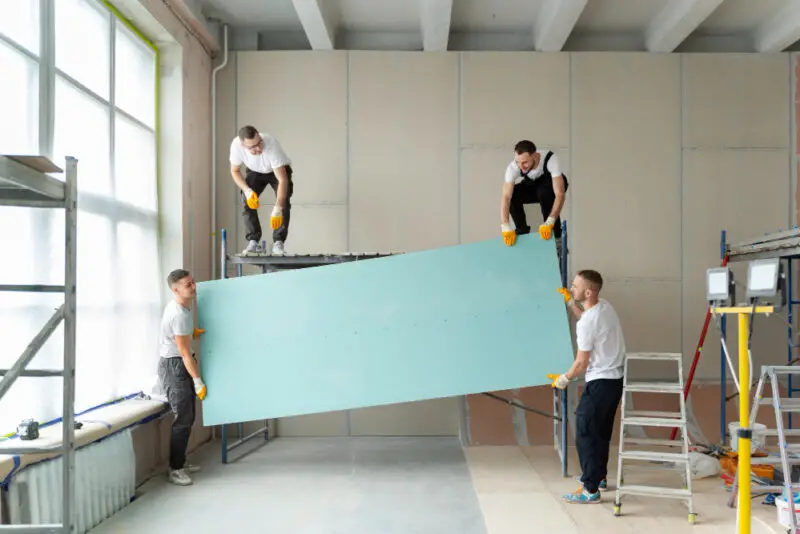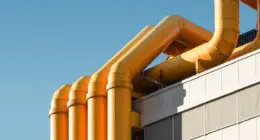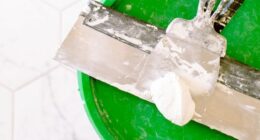Drywall and Sheetrock are terms often used interchangeably, but Sheetrock is actually a brand of drywall. Both are gypsum-based panels used for walls and ceilings in construction.
TL;DR Drywall Vs. Sheetrock
Drywall is a generic term used to describe panels made from gypsum plaster sandwiched between two layers of paper. Sheetrock is a brand name for a specific type of drywall manufactured by USG Corporation.
Drywall tends to be more affordable and widely available, while Sheetrock offers superior durability and ease of installation.
What is drywall?

Drywall, also known as plasterboard or wallboard, is a versatile construction material that plays a vital role in modern building projects. It is essentially made up of gypsum plaster sandwiched between two layers of paper.
This combination creates a strong and durable panel that can be easily installed to create smooth interior walls and ceilings.
What is sheetrock?
Sheetrock is a term often used interchangeably with drywall, but it actually refers to a specific brand of gypsum board.
Developed by the United States Gypsum Company in the early 20th century, Sheetrock has become synonymous with drywall due to its widespread popularity.
Made from a combination of gypsum plaster and paper facings, sheetrock panels are lightweight yet strong.
They provide an excellent surface for walls and ceilings, offering durability and easy installation. The paper covering on both sides helps prevent cracks and provides a smooth finish that can be painted or textured.
Drywall Vs. Sheetrock – Key differences
| Aspect | Drywall | Sheetrock |
|---|---|---|
| Definition | Gypsum-based panel used for walls and ceilings. | Brand name for a type of gypsum-based panel. |
| Origin | Generic term; various manufacturers. | Trademarked by USG Corporation. |
| Interchangeable | Yes, often used to refer to all similar panels. | No, specifically refers to USG product. |
| Usage | Generic term for gypsum panels in construction. | Specific brand for gypsum panels. |
| Popularity | Widely used term in the construction industry. | Commonly used but technically a brand. |
Types of Drywall and Sheetrock
There are various types of drywall and Sheetrock available, each designed for specific applications.
Standard Drywall/Sheetrock
- Used for most interior walls and ceilings.
- Available in different thicknesses: 1/4″, 3/8″, 1/2″, and 5/8″.
Moisture-Resistant Drywall
- Contains additives to resist moisture, suitable for bathrooms, kitchens, and humid environments.
- Often referred to as “green board.”
Fire-Resistant Drywall
- Contains fiberglass or other fire-resistant materials.
- Used in areas where fire protection is important, like garages or near fireplaces.
Soundproof Drywall
- Designed to reduce sound transmission.
- Has additional layers or materials to dampen sound.
Impact-Resistant Drywall
- Reinforced with fiberglass or other materials to withstand impacts.
- Used in high-traffic or vulnerable areas.
Benefits of drywall and sheetrock
Drywall and Sheetrock offer numerous benefits, making them popular choices for interior construction.
- Ease of Installation: Both drywall and Sheetrock are relatively easy to install, especially compared to traditional plaster walls. They can be quickly and efficiently hung and finished.
- Cost-Effective: Drywall and Sheetrock are cost-effective options for wall and ceiling construction, making them a budget-friendly choice for residential and commercial projects.
- Versatility: They can be used in a variety of applications, from walls to ceilings, and are suitable for both residential and commercial spaces.
- Smooth Surface: Once finished, drywall and Sheetrock provide a smooth and uniform surface that’s ready for painting, wallpapering, or other finishing treatments.
- Fire Resistance: Fire-resistant variants of drywall and Sheetrock are available, offering increased fire protection in buildings.
How drywall and sheetrock are manufactured?
Drywall and Sheetrock are manufactured using a similar process. Here’s a general overview of how they are made:
Mining and Preparation of Gypsum:
- The primary material used in drywall is gypsum, a mineral rock. Gypsum is mined from quarries or extracted from natural deposits.
Grinding and Heating:
- The mined gypsum is crushed into small particles and heated to remove excess water, converting it into a fine powder known as “calcined gypsum” or “stucco.”
Mixing and Forming:
- The calcined gypsum is mixed with additives such as starch, paper pulp, or foaming agents to enhance properties like workability and fire resistance.
- This mixture is then fed between two continuous rolls of paper, creating a sandwich-like structure.
Formation of Panels:
- The gypsum mixture is fed onto the bottom layer of paper.
- A top layer of paper is added, and the three layers (gypsum mixture, bottom paper, and top paper) are compressed and passed through a forming machine.
Cutting and Drying:
- The formed panels are cut to the desired length and width.
- The panels are then moved through a drying kiln to remove any remaining moisture from the gypsum mixture, resulting in hardened gypsum core.
Finishing and Packaging:
- Once dry, the panels are trimmed, checked for quality, and packaged for distribution.
- The edges may be tapered or squared to allow for smoother joint finishing during installation.
Additional Processing (Optional):
- Some specialized types of drywall, like moisture-resistant or fire-resistant variants, may undergo additional treatment during the manufacturing process.
Sheetrock is a brand name owned by USG Corporation, and the term “drywall” is used generically to refer to gypsum-based panels made by various manufacturers.
Image Credits
Featured Image By – Freepik
Image 1 By – Freepik








